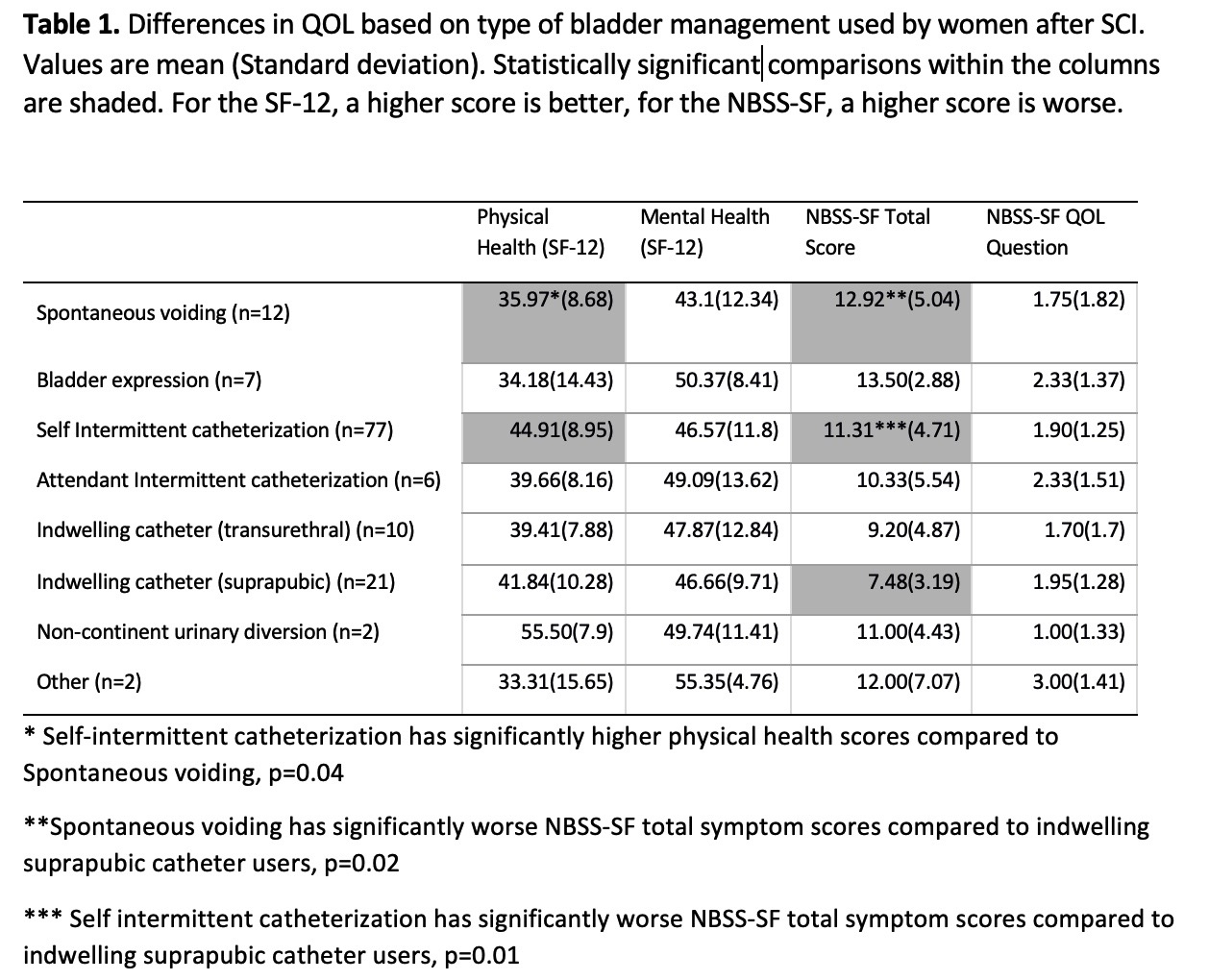Back
Poster, Podium & Video Sessions
Podium
PD24: Urodynamics/Lower Urinary Tract Dysfunction/Female Pelvic Medicine: Neurogenic Voiding Dysfunction
PD24-06: Bladder related quality of life in women with spinal cord injury
Saturday, May 14, 2022
10:20 AM – 10:30 AM
Location: Room 245
Ann Dekalo, London, Canada, Jeremy Myers, Salt Lake City, UT, Michael Kennelly, Charlotte, NC, Blayne Welk*, London, Canada

Blayne Kaili Welk, MD, MSC
Western University
Podium Presenter(s)
Introduction: The proportion of women with a spinal cord injury (SCI) is growing, and they have different anatomical and functional considerations compared to men. Our objective was to examine bladder and overall quality of life (QOL) among women with SCI.
Methods: We used data from a prospective, multi-center, cross-sectional study that was carried out from May 2019 to September 2020. Clinical and demographic details were obtained during an in-person interview, and validated with random chart audits. Participants completed two QOL instruments: the Neurogenic Bladder Symptoms Score-Short Form (NBSS-SF) and the SF-12 general QOL instrument (which measures overall physical and mental health QOL).
Results: Our cohort included 135 women with SCI (median age 50 (interquartile range 38-58), 40% cervical SCI). In general QOL, women with SCI had physical functioning scores similar to men, but significantly lower mental component scores on the SF-12 questionnaire (46.85 vs. 49.76, p=0.01). Women had significantly higher (worse) overall NBSS scores and NBSS continence domain scores (10.76 vs 9.08 p<0.001 and 4.71 vs 3.66 vs p<0.001, respectively). There were significant differences between overall QOL measures, and bladder symptoms based on bladder management techniques (Table 1). The NBSS-SF symptom scores were significantly higher (worse) among the 11 women who used CIC in the past and switched to an indwelling catheter compared to the 17 women who used an indwelling catheter and switched to CIC (13.06 vs. 8.18, p=0.013). NBSS-SF symptom scores were significantly better among women who use overactive bladder medications compared to women who did not (8.43 vs. 11.9, p=0.02). NBSS-SF QOL domain scores were significantly better among women who underwent surgery and used medications than the 51 women who didn’t use any of the treatments (1.3, 1.33, and 2.27 respectively, p=0.01).
Conclusions: Women have more bladder symptoms (specifically incontinence) compared to men. Symptom burden and overall QOL are different among women who use different bladder management techniques. Further studies are needed in women with SCI to examine the treatment of incontinence and bladder dysfunction.
Source of Funding: This study was partially supportd by a Craig H. Neilsen Foundation Psychosocial Grant.

Methods: We used data from a prospective, multi-center, cross-sectional study that was carried out from May 2019 to September 2020. Clinical and demographic details were obtained during an in-person interview, and validated with random chart audits. Participants completed two QOL instruments: the Neurogenic Bladder Symptoms Score-Short Form (NBSS-SF) and the SF-12 general QOL instrument (which measures overall physical and mental health QOL).
Results: Our cohort included 135 women with SCI (median age 50 (interquartile range 38-58), 40% cervical SCI). In general QOL, women with SCI had physical functioning scores similar to men, but significantly lower mental component scores on the SF-12 questionnaire (46.85 vs. 49.76, p=0.01). Women had significantly higher (worse) overall NBSS scores and NBSS continence domain scores (10.76 vs 9.08 p<0.001 and 4.71 vs 3.66 vs p<0.001, respectively). There were significant differences between overall QOL measures, and bladder symptoms based on bladder management techniques (Table 1). The NBSS-SF symptom scores were significantly higher (worse) among the 11 women who used CIC in the past and switched to an indwelling catheter compared to the 17 women who used an indwelling catheter and switched to CIC (13.06 vs. 8.18, p=0.013). NBSS-SF symptom scores were significantly better among women who use overactive bladder medications compared to women who did not (8.43 vs. 11.9, p=0.02). NBSS-SF QOL domain scores were significantly better among women who underwent surgery and used medications than the 51 women who didn’t use any of the treatments (1.3, 1.33, and 2.27 respectively, p=0.01).
Conclusions: Women have more bladder symptoms (specifically incontinence) compared to men. Symptom burden and overall QOL are different among women who use different bladder management techniques. Further studies are needed in women with SCI to examine the treatment of incontinence and bladder dysfunction.
Source of Funding: This study was partially supportd by a Craig H. Neilsen Foundation Psychosocial Grant.


.jpg)
.jpg)